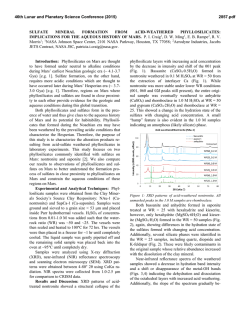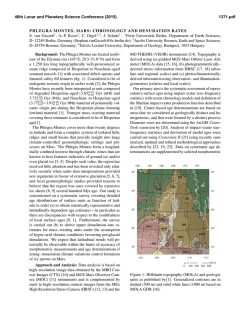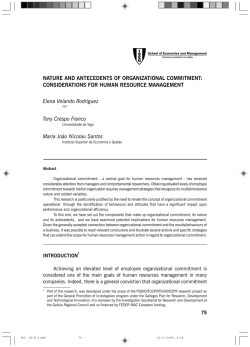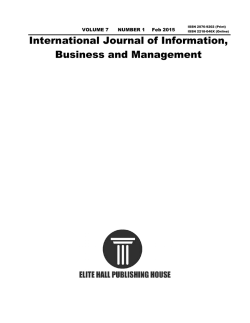
2230
46th Lunar and Planetary Science Conference (2015) 2230.pdf POSSIBLE SOURCES OF SULFATES IN THE SISYPHI MONTES REGION OF MARS. S. E. Ackiss and B. Horgan, Department of Earth, Atmospheric, and Planetary Sciences, Purdue University, West Lafayette, IN 47907 ([email protected]) Introduction: Sulfate salts are found throughout the Martian geologic record [1], and are interpreted as indicating environments that were once aqueously active. They are hypothesized to reflect a transition from a wet, neutral-pH early Mars to a hyper-arid world where fluids are saline, acidic, and rare [2]. Sulfates have been dated to occur from the Early or MidNoachian [3] through the Late Amazonian [4], so they have likely formed throughout Martian history via multiple processes in diverse settings. The high southern latitudes have received little attention to date in the search for sulfates and other hydrated minerals. Studies that have focused on this region have shown strong sulfate detections concentrated throughout the Sisyphi Montes region (340–40°E and 55–75°S), as well as weaker signatures throughout the 55–75°S latitude band [5, 6]. Here we present a new analysis of the mineralogy, composition, and context of sulfates in the Sisyphi Montes region. Investigating the composition of these sulfate assemblages in more detail will help to determine the sources of the sulfates and thus the types of aqueous environments that occurred in this region of Mars and their potential habitability (pH, water activity, etc.). Data sets and Methods: We utilize data from the Compact Reconnaissance Imaging Spectrometer for Mars (CRISM) as well as multiple other global data sets. Basemap data includes Mars Orbiter Laser Altimeter (MOLA) topographic data (128 pix/deg or ~460 m/pix) as well as visible images from Mars Orbiter Camera (MOC) and Context Camera (CTX; 6 m/pix) for morphologic data. Each basemap was imported into ArcGIS 10.2.2 and used to construct a mineralogic map. The CRISM instrument [7] acquires visible and near-infrared (0.36-3.9 µm) data that record information about primary and secondary mineralogy. For this study, multispectral mapping (MSP) strips were used to evaluate possible sulfate signatures in the Sisyphi Montes region. MSP strips were imported into ArcGIS to create a nearly spatially continuous mosaic at a scale of 200 meter/pixel. Using mapping strips helps to study regional trends and overall distributions. CRISM targeted hyperspectral observations were also used in order to study the spectral characteristics of the sulfate outcrops identified from the MSP data. For each image we tabulated location, year and date, IR detector temperature (<-148°C), and any at- mospheric hazes or surface frosts visible in browse images. In order to reduce the influence of seasonal ice and ubiquitous adsorbed water at these high latitudes, we focused on data that was taken at solar longitudes between 180-360⁰ (southern spring and summer) [8]. Images were then evaluated using standard procedures in the CRISM Analysis Toolkit (CAT), including the “volcano scan” atmospheric correction [9]. Spectral summary parameters [10] indicating absorption bands associated with hydration and sulfates were used to identify regions of interest. We extracted spectra and divided by spectrally neutral regions in the same scene to suppress systematic artifacts, dust, and residual atmospheric absorptions, a common method in CRISM data analysis. The resulting ratio spectra were analyzed from 0.4 to 2.6 µm and visually compared to laboratory spectra to identify possible hydrated mineral constituents. Preliminary Results: FRT00007E11 is located at the base of a volcanic structure (Figure 1a) and shows a range of spectral diversity throughout the scene. The summary parameter map (Figure 1b) shows an RGB combination consisting of summary parameters SINDEX, BD1750, and BD1900, respectively. White pixels show signatures with sharp absorptions at 1.75 and 1.92 µm with a 2.44 µm shoulder. Cyan pixels have absorptions at 1.44, 1.75, 1.92, 2.21, and 2.44 µm. Blue pixels show a slight 1.43 µm absorption with a broad 1.73 µm and distinct 1.92 and 2.46 µm absorptions. Pink pixels show absorptions at 1.42, 1.92, and 2.46 µm. Color coordinated spectra can be seen in Figure 1c. Discussion: By correlating the mineralogy with the morphology of this region, we can place constraints on the sources of the sulfates. We are considering four hypotheses for the origin of the high latitude sulfates: (1) Ice-dust weathering: The sulfates may have formed within ice when sunlight caused minor melting and weathering of embedded dust, as proposed for the north polar sulfates [11]. We hypothesize that this weathering mechanism could have occurred in the south polar layered deposits when the southern permanent cap was more extensive, perhaps depositing the more widely distributed class of southern sulfates during sublimation. (2) Volcanic alteration: Sulfates in the southern high latitudes have been observed on the mountains of the Sisyphi Montes region [5,6], which have been interpreted as volcanoes that erupted under a Hesperian 46th Lunar and Planetary Science Conference (2015) ice sheet [12]. These sulfates might have formed via hydrothermal [13,14], acidic snow, or acid fog alteration related to volcanic activity [15]. (3) Subglacial weathering: In areas lacking volcanoes, sulfates have also been hypothesized to have formed from subglacial melting. Subglacial melting would have caused a concentration of sulfate deposits along depositional features after discharge of subglacial flow [15, 16]. (4) Playa evaporation: Large impact basins may have trapped and altered eolian sediments through the discharge and evaporation of regional groundwater, depositing sulfates in a playa-like environment [7, 17, 18]. Sulfate concentrations may have been locally enhanced prior to deposition within the basins by hydrothermal alteration at the time of impact. Conclusions: Spectral signatures in FRT0007E11 are concentrated around boulders that form curvilinear structures [5, 6]. Hypotheses 1-3 are the most consistent possible sources due to the morphology of the region. Because the sulfate signatures in FRT0007E11 are located on higher terrain instead of playa-like environments, hypothesis 4 can be ruled out. Hypotheses 13 will be further investigated to constrain the sources of these deposits. Acknowledgements: S. Ackiss thanks the NASA Earth and Space Science Fellowship as well as the Purdue Doctoral Fellowship for support. References: [1] B. L. Ehlmann and C. S. Edwards (2014), Annu. Rev. Earth Planet. Sci., vol. 42. [2] J.-P. Bibring et al. (2006), Science, vol. 312, pp. 400–404. [3] J. J. Wray et al (2010), Icarus, vol. 209, pp. 416– 421. [4] N. Mangold et al. (2010), Earth Planet. Sci. Lett., vol. 294, pp. 440–450. [5] S. E. Ackiss and J. J. Wray (2014), Icarus, vol. 243, pp. 311–324. [6] J. J. Wray et al. (2009), Geology, vol. 37, pp. 1043–1046. [7] S. Murchie et al. (2007), J. Geophys. Res. Planets, vol. 112. [8] A. J. Brown et al. (2010), J. Geophys. Res. Planets, vol. 115, no. E2, p. E00D13, 2010. [9] F. Morgan et al. (2011) LPSC Abstract # 2453. [10] S. M. Pelkey et al. (2007), J. Geophys. Res. Planets, vol. 112. [11] P. B. Niles and J. Michalski (2009), Nat. Geosci., vol. 2, pp. 215–220. [12] G. J. Ghatan and J. W. Head (2002), J. Geophys. Res. Planets, vol. 107, p. 5048. [13] M. Settle (1979), J. Geophys. Res., vol. 84, pp. 8343–8354. [14] K. L. Tanaka (2006), LPI Contrib., vol. 1323, p. 8024. [15] Y. Langevin et al. (2005), Science, vol. 307, pp. 1584–1586. [16] K. E. Fishbaugh et al. (2007), J. Geophys. Res. Planets, vol. 112, p. 7002. [17] J. C. Andrews-Hanna et al. (2007), Nature, vol. 446, pp. 163–166. [18] K. A. Lichtenberg et al. (2010), J. Geophys. Res. Solid Earth, vol. 115. 2230.pdf Figure 1. Location and spectral diversity of CRISM image FRT0007E11. (a) A Sisyphi Montes volcanic structure with THEMIS Daytime IR and MOLA basemaps; location of FRT0007E11 is outlined in black. (b) Summary parameter map (R: SINDEX, G: BD1750, B: BD1900). (c) Spectra contained in FRT0007E11 compared to laboratory spectra of Mg sulfate, gypsum, bassanite, and analcime.
© Copyright 2025






